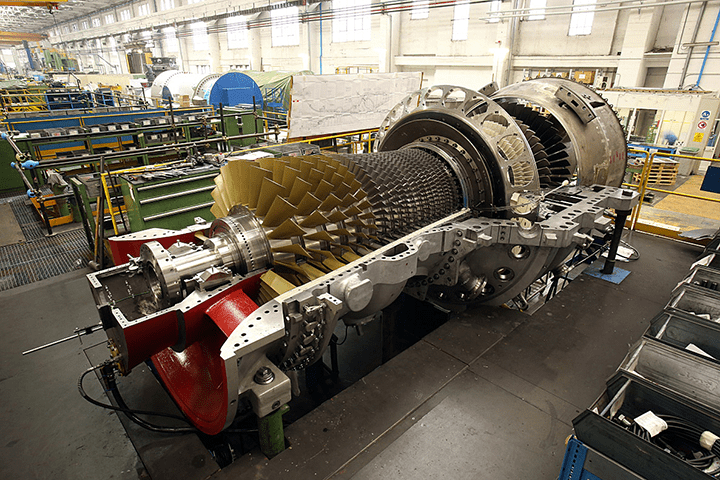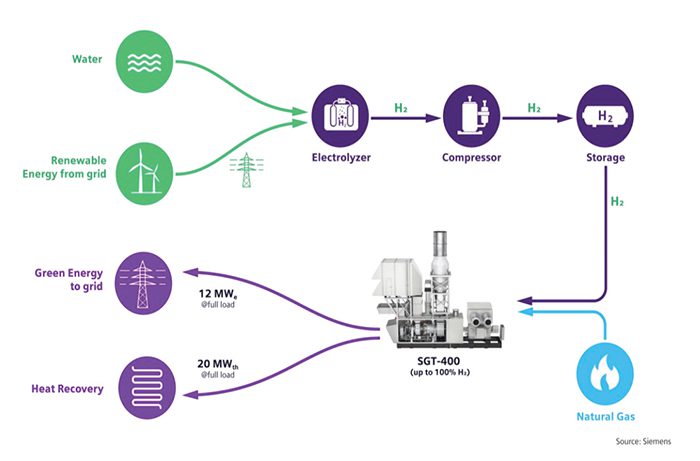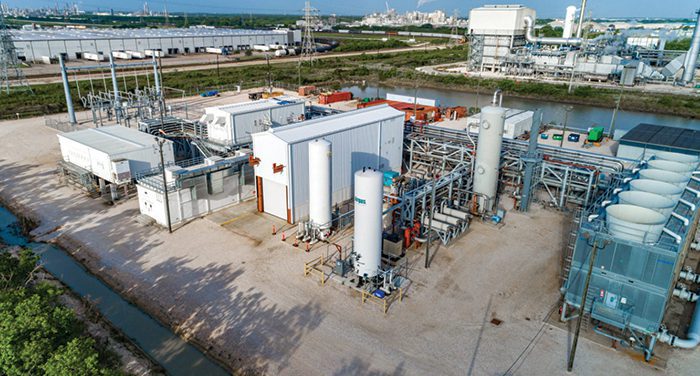Gas Turbine Technology Advances That Could Boost Their Future Relevance

Gas turbines have grown into a hallmark of the modern power system for their high efficiency, reliability, operational flexibility, fuel flexibility, and low-emission power options. But if gas turbines are to remain relevant amid the anticipated proliferation of renewables, energy storage, and decarbonized gas-including hydrogen, ammonia, synthetic methane, and other green fuels-research and development (R&D) to enable emerging applications must be a high priority, the global gas technology industry concedes.
According to ETN Global, a Brussels-based nonprofit trade group representing the entire gas turbine technology value chain, future gas turbine applications will include the hybridization of gas turbine technology with renewables and storage, and retrofitting them to ensure they can combust high volumes of hydrogen and other renewable fuels. But modern gas turbines must also operate with increased energy efficiency and performance, and be even more operationally flexible. Finally, along with a reduced carbon output at existing assets, future systems must work toward zero emissions or integrate carbon capture, utilization, and storage (CCUS) solutions.
ETN laid out its recommendations for gas turbine technical areas that deserve R&D priority in a July-released biennial report. The recommendations were informed by a diverse board that includes academics from European institutions; utilities, including Enel and Uniper; gas turbine manufacturers, such as Siemens Energy, Ansaldo Energia, and Baker Hughes; energy companies, including Equinox and TotalEnergies; and government researchers, such as from Germany's national aeronautics and space research center, and the Norwegian Research Centre.
In the report, the board highlights recent environmental developments in Europe that are posing new urgency and placing new demands on technology development. These include looming coal and nuclear phase-outs, ambitious net-zero policy frameworks, new hydrogen and methane reduction strategies, a review of the Industrial Emissions Directive, and the emergence of sustainable finance. Following is a broad overview of the technical areas highlighted in the report.
The Significance of Improved Operational FlexibilityWhile the changing power landscape will require reliance on open-cycle gas turbines (OCGTs) or combined cycle gas turbines (CCGTs) to provide flexible backup in the near future, over the long term, gas turbine research must support the enhanced capability for fast load changes. As counterpart to [renewable energy system] partial dispatchability, power plants based on GT-derived technology will be required to start-up and shut down quickly (recently built combined cycle plants feature 15-30 minutes hot start-up, 60 minutes warm start-up), react to load changes (some case studies suggest up to 40-50 MW/minute) while minimising the impact on components life consumption and emissions," the report says. This will require scrutiny at both a component level (design to life") and a system-level (to include, for example, integration with batteries, compressed air or liquified air storage, and power-to-X-to-power systems [Figure 1]).
 |
1. HYFLEXPOWER, a four-year project to demonstrate a fully integrated power-to-hydrogen-to-power project at industrial scale and in a real-world power plant application, is converting a 12-MWe combined heat and power (CHP) plant at Engie Solutions' Smurfit Kappa pulp-and-paper industrial site in Saillat-sur-Vienne, France. According to Siemens Energy, which is supplying a 100% hydrogen-capable industrial gas turbine, the project will this year install the hydrogen production, storage, and supply facility. Next year, it will embark on an initial demonstration to combust a natural gas and hydrogen mix. Courtesy: Siemens Energy |
Fast cycling, however, will also require combustion advances to address emissions. Design changes addressing material and component fatigue should also be a priority, the report says, noting a probability of severe harm, such as damage accumulation on hot gas path components, degradation of thermal barrier coatings, creep-fatigue of turbine buckets, cracking and degradation of combustor." This aspect is compounded by emerging requirements to reduce capital and operational expenditures to keep gas turbines competitive in a cutthroat market. R&D will need to focus on the entire plant, including the bottoming cycle. Emerging contenders to the classic water-steam bottoming cycle so far are Organic Rankine Cycles and carbon dioxide (CO2)-based cycles (either pure or with dopants, Rankine and Brayton) with different cycle configurations. Operational flexibility, however, is currently benefiting from digital tools, including advanced instrumentation and new sensor technologies.
Boosting Power Generation EfficiencyWhile original equipment manufacturers (OEMs) report heavy-duty gas turbines are now able to achieve efficiencies of more than 42.5% (ISO standard) in simple cycle configuration and above 62.5% in combined cycle mode, the average efficiency of new installations in Europe is much lower (~50%) than the aforecited values," the report notes. Efficiencies are also challenged by frequent operation in partial-load conditions. Owing to inherent thermodynamic and material limitations, some voices from the industry are already calling for other cycles," such as the reheat Brayton cycle, for future CCGTs.
Meanwhile, though gas-path design of compressors and turbines has achieved unprecedented optimization, further efficiency gains could be attained through turbine clearance control. Future systems able to further minimise tip-leakage flow at the compressor and, more importantly, the turbine whilst avoiding physical contact between rotating and stationary parts are needed," the report says. Efficiency gains may also come from improved designs of the secondary gas path, multi-objective topological optimization, and active control of cooling flows. Other opportunities may also exist for single pressure, reheat bottoming cycles with either subcritical or supercritical live steam pressures and maybe duct firing for enhanced flexibility."
Adapting to an Extended Fuel SpectrumGas turbines today mainly use natural gas as fuel, but OEMs have embarked on efforts to make them much more fuel-flexible, and some have even laid out roadmaps to get to 100% hydrogen combustion. The report notes: Fuel gas mixtures (syngas, hydrogen) and diluents (CO2, H2O) come on the scene as new gas turbine-based processes and new fuel resources (biofuel, shale gas, LNG [liquefied natural gas]) are being proposed for power generation and industrial applications." The spectrum also includes emerging carbon-neutral products, such as biomass-to-liquid and power-to-X.
However, these prospects could add new operational challenges, such as flame stability and emission compliance issues. The challenges can also be exacerbated if flexible-fuel switch-over procedures are to be considered."
Tackling the Emissions BurdenGas turbine nitrogen oxide (NOx) emission levels have continuously fallen over the past few decades owing to stringent standards. However, more and more projects are adopting 15 parts per million (ppm) of NOx as an emission target. Some regions, meanwhile, have even asked for single-digit ppm NOx levels. The challenges ahead for gas turbine technology are to address emission limits at part-load and in dynamic operation schemes, as well as with the use of liquid fuels, and hydrogen and hydrogen-rich fuel gases. Alternatives to conventional lean premix combustion have shown promise, the report notes.
Reductions of CO2 emissions, on the other hand, can be achieved through improvements in efficiency, process hybridization, the use of low-carbon fuels, or with the integration of CO2 capture technologies. Among options under exploration is the integration of CO2 capture into renewable fuel-based power generation (such as biofuel), which results in negative CO2 emissions and might be an interesting option when considering emission trading as part of the business plan."
The integration of post-combustion CO2 capture with gas turbines, however, will require selecting a suitable technology that optimizes the integration while maintaining plant flexibility. Options that should be further researched include the integration of conventional" post-combustion amine scrubbing, or other liquid-based technologies, to minimize costs and energy penalties. Alternative post-combustion capture technologies, such as calcium-looping cycles or solid sorbents using pressure or temperature swing concepts, may allow for improved heat integration (resulting in lower operating costs). Other options include exhaust gas recycling, including enhanced" recycle options that use CO2 separation membranes).
Advanced Cycles Are PromisingThe report is notably pessimistic that incremental gas turbine efficiency gains and technology leaps over the near term will be able to achieve stringent carbon targets set out, for example, by the European Commission for 2030. But gas power still has a crucial role for backup and grid stabilization, it notes. That's why the significance of advanced cycles is growing, it says.
Advanced cycles are one key element to comply with the increasing requirements, and different technologies provide opportunities both from a pure thermodynamic point of view and from a system integration perspective." However, challenges here, too, are hefty: Most advanced cycles gas turbines (GTs) are interconnected to other systems and components, or even processes such as high-temperature fuel cells or solar air heaters. Their integration often requires a change in mass flow rates of compressor or turbine as well as different working fluids. Most GTs currently on the market are not designed for this type of process integration," it notes. It suggests future R&D activities should target the development of concepts for easy-to-integrate" and flexible gas turbines, since otherwise each cycle would need its specific gas turbine adaptation." Attention should especially be devoted to upgrade and conversion applicability, it says, considering that most of the current installed capacity, mainly composed of traditional power plants, will continue to serve in a 2030 energy landscape and beyond.
Getting that accomplished, however, will require deep study, and testing of materials and coatings. It will also need reliable numerical simulation tools, including a system of tools that allows the analysis of advanced integrated cycles without needing to manually iterate between power plant simulation and process modeling tools. Tools must also be developed for transient analysis of the process because gas turbines are increasingly used for energy balancing, it says.
Among several promising advanced cycles the report highlights are supercritical CO2 cycles (Figure 2). Commercial systems are currently available for waste heat recovery at the 5 to 10 MW scale [on a technological readiness level (TRL) of 9] whilst the technology is in the pre-commercial phase (TRL7-8) for natural gas applications." Yet, these systems still need development of compact, highly efficient, cost-effective heat exchanger designs, high-temperature oxycombustion systems, and improved turbomachinery designs. System integration as a function of scale must also be better understood, insofar as this turns out critical to optimise the type of drive of compressors and pumps and the operation of the system in off-design conditions," it says.
 |
2. Several 280-MW NET Power plants that will use the Allam-Fetvedt Cycle, a novel power cycle that uses supercritical carbon dioxide, are under development in the U.S. and UK. This image shows NET Power's test facility in La Porte, Texas, which achieved first fire of a commercial-scale 50-MWth combustor in May 2018. Courtesy: NET Power |
Though it still needs research at the fundamental and applied levels, pressure gain combustion, another advanced cycle, has the potential to achieve the same time-averaged combustor exit temperature as conventional Brayton cycles but at a higher pressure level. Wet cycles-which use a working fluid with a high water content-present different options with TRLs between 2 and 9 (the most mature being the Cheng Cycle), but R&D is needed here, too, on different components and at a system level.
Organic Rankine cycles (ORCs) for stationary power generation are already currently commercial (for use in small- and medium-scale applications), but further research could enhance performance and cost-effectiveness. New cycle concepts enabling higher thermal efficiency are needed through the exploitation of features such as supercritical vapour generation, cascade layouts or cycles including wet expansion, tailored to the singularities of certain applications like waste heat recovery," the report notes.
Emerging Considerations: Systems Integration and Energy StorageThe integration of gas turbine technology in other systems can offer innovative solutions, but several technical challenges need to be tackled. While commercial pilots are in the works for compressed air and liquid air energy storage, challenges involve areas of fluid storage and heat/cold storage.
Thermal storage, meanwhile, could be used in several different power cycles. The current state of the art of high temperature storage includes phase change (molten salts) technology; while different salt combinations (binary and ternary) are being looked at to go above 520C and other media are being investigated (like the promising silicon-based technology or calcium/carbon looping salts based technology). Stability, maintenance requirements and material compatibility are all issues to be addressed in this field," the report says.
The possibility of integrating thermal storage for solar hybrid gas turbines, meanwhile, may require designing unique cycles that would separate the combustion system of the gas turbine unit to allow thermal input from the heat storage, as well as managing the balance between solar and chemical energy in transient operations." Overall, the report notes, all energy storage schemes are limited in terms of turndown or operational flexibility.
Promising systems that combine different energy conversion systems, meanwhile, include one using fuel cells in different parts of a conventional energy conversion plant. Even though scale is still limiting overall power output, fuel cells can be used to work as a surrogate combustion' system for gas turbine derived technology, as they work (especially the Solid Oxide Fuel Cells) at high temperature," it says. A big challenge here, however, is the transient management-the two conversion systems have very different reaction times, with gas turbine being the most reactive, the report notes.
-Sonal Patel is a POWER senior associate editor.
The post Gas Turbine Technology Advances That Could Boost Their Future Relevance appeared first on POWER Magazine.